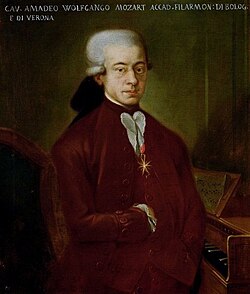
The Serenade No. 6 in D major, K. 239, Serenata notturna, was written by Wolfgang Amadeus Mozart in Salzburg, in 1776, for a group of four soloists and orchestra. Mozart's father, Leopold Mozart, wrote the title and a January 1776 date on the original manuscript. [1]
It has three movements.
- Marcia (maestoso)
- Minuetto
- Rondo (allegretto)
It is a concertante work for a group of four soloists, two violins, viola and double bass, and a string orchestra with two violins, one viola, one cello, and one timpani.
The title Serenata notturna has also been used by Robin Holloway for a work for four horns and orchestra (his opus 52, 1982). [2]